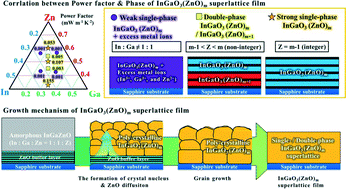A combinatorial approach to solution-processed InGaO3(ZnO)m superlattice films: growth mechanisms and their thermoelectric properties
Abstract
Multicomponent amorphous InGaZnO thin films with several metal cations have been synthesized with flexible chemical composition control based on a sol–gel process, and a combinatorial approach through a sol–gel process enables us to perform a systematic survey to fluently find the best film properties. Contrary to amorphous films, crystalline InGaO3(ZnO)m requires a refined chemical composition ratio among metal cations. These ratios are expected to affect the growth evolution and thermoelectric properties of two-dimensional InGaO3(ZnO)m superlattice structures with various compositional combinations. Here, we explore a combinatorial approach to the ratio of metal cations using various mole fractions of metal precursors in InGaZnO sol for amorphous InGaZnO films fabricated on an epitaxial ZnO buffer layer, and then, they were crystallized with various chemical compositions. The crystallized InGaO3(ZnO)m films can be classified as strong single-phase InGaO3(ZnO)m, double-phase InGaO3(ZnO)m/InGaO3(ZnO)m+1, and weak single-phase InGaO3(ZnO)m with excess metal ions. Among them, the strong single-phase InGaO3(ZnO)m films with superlattice structures showed superior thermoelectric power factors. The detailed microstructural growth evolution of single- and double-phase InGaO3(ZnO)m films was investigated using transmission electron microscopy.


 Please wait while we load your content...
Please wait while we load your content...